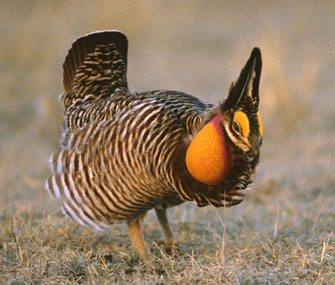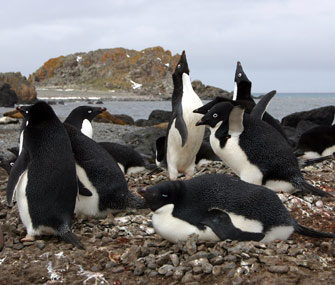The Birds and the Birds and the Bees
Published on April 15, 2013

It’s spring, and birdsongs are starting to fill the air. The tunes are so pretty that it’s easy to forget what this soundtrack is all about: the birds and the bees.
In fact, the song we’re hearing is mostly male birds holding forth about how great they are, a message that has a different meaning depending on who’s listening. “It says to the girls, ‘Hey, I’m fit, come hither,’ and it says to the guys, ‘Get lost or there could be trouble’,” says George Armistead, events coordinator for the American Birding Association.
Armistead has spent many years as a full-time bird tour leader and guided tours on every continent. Throughout his career, he has seen some interesting things when it comes to birds and mating. As Armistead says, “In the process of looking for birds, we see both things we want to see and, sometimes, would rather not see.”
This has inspired Armistead to develop a talk he gives called — what else? — “pOrnithology: The Birds and the Birds and the Bees.” He agreed to tell us some of the stories, for which we’re grateful — we think.
Relationships: It's Complicated
For many people, birds are a symbol of devotion. “One of the most common questions I get asked is: Do birds mate for life?” says Armistead. Sadly, the answer is mostly no. But he’ll reassure you that most birds are monogamous — depending on how you define monogamy.
“There are different versions of monogamy,” Armistead explains. There are birds that are more or less serial monogamists — they pair up for a breeding season, but might take a different mate the next season. This includes most familiar songbirds like warblers and sparrows.
Then there are the birds that are called “socially monogamous.” They’ve got a mate, and they tend a nest together, but it’s what you might call an “open relationship.” These birds fooled even scientists for a long time, until DNA testing allowed researchers to find out who really was the daddy of a clutch of baby birds. For one species, the fairy wren, almost three quarters of the young are the result of what’s politely called “extra-pair fertilization.”
Other birds don’t even bother to maintain a surface veneer of respectability. Take species like the sage grouse and prairie chicken, where in breeding season the males all gather to display the goods in a process called “lekking.” “These lek sites go back many decades if not centuries, so the females know exactly where to go,” says Armistead.
The males start the show at the crack of dawn and perform a song and dance, and the females watch to see who does the traditional dance the best. They pick a male, mate and move on. “That’s pretty much the male’s involvement, in these species,” says Armistad. “He’s meant to look good, be fit, breed and then the female takes it from there. The females don’t come to these leks looking for long-term meaningful relationships.”

If that’s not disillusioning enough, Armistead has more bad news for you. “The oldest profession is not unknown in the bird world,” he says. Birds don’t have money, of course, but they do have things they value, and the more scientists look, the more they find examples where birds exchange these resources for sex.
Some birds defend a feeding territory, like the Purple-Throated Carib, a type of hummingbird. They’ll vigorously defend a flowering bush from another male, but every so often, Armistead says delicately, “he will allow a female to feed, given that a certain arrangement is achieved.” And then there’s the Adelie penguin. They live in Antarctica, where there’s not much to build a nest from except little pebbles, and even those aren’t very abundant. “The females value these enough that if a male who isn’t their mate brings enough stones, she’ll permit that male to have sex with her,” he explains.
Caught in the Act
When it comes to actually doing the deed, some birds sure seem to overdo it. Copulation for the Dunnock, or hedge sparrow, only lasts a second, but they copulate a hundred times in a day.
There are also birds whose enthusiasm for lovemaking is, as Armistead puts it, more about quality than quantity. A pair of Vasa parrots from Madagascar was once timed copulating for almost 90 minutes. This was in captivity where they were safe from predators, and parrots live a long time, though, so Armistead says he's even more impressed by the Fiery-Throated hummingbird.
“They have a much shorter lifespan than a parrot,” he says, “and they’ve been timed copulating in the wild for 56 minutes. That represents a sizable portion of the lifespan for some hummingbirds.”
Private Parts
For some birds, the oddest part of their mating is the actual parts they do it with. Most birds don’t have the sort of male organs we mammals are accustomed to. Both male and female birds have a “cloaca,” a multipurpose orifice for elimination, fertilization and egg laying, and copulation consists of basically pressing the two holes together.
That might not sound like much fun, so some birds have done something about that. The male of the Australian fairy wren has a protuberance called the “cloacal tip,” and the scientists who studied it called their journal artice, “Good Vibrations.” “They believe it feels good in the female,” says Armistead, “that this is its primary function, to gain more matings with females.”
There are also some species of birds where the males do have penises, including ducks and grebes. As Armistead explains, for birds that mate in water, just bumping holes together isn’t a reliable way to get the sperm where it needs to go.
No matter which parts each bird species has or how they go about it, the goal is the same: mating. So next time you hear a birdsong, remember it’s not just about the birds — it’s about the birds and the bees.





